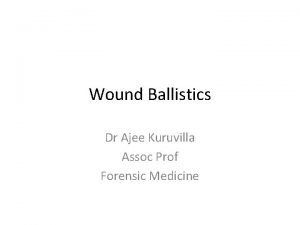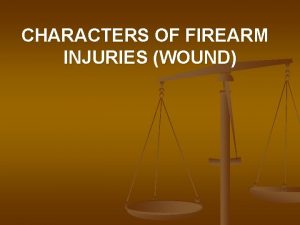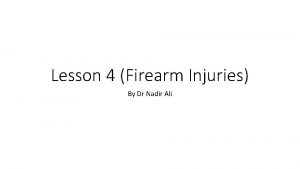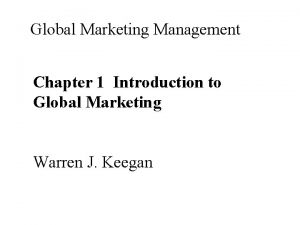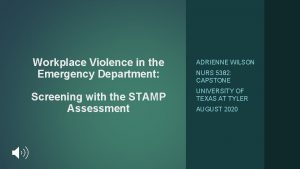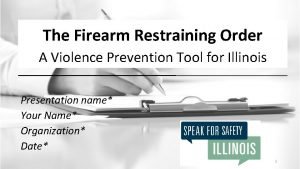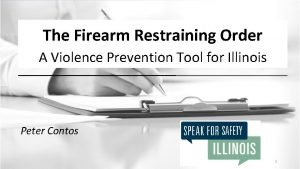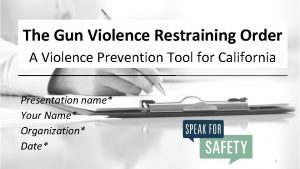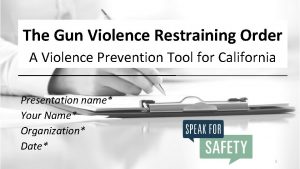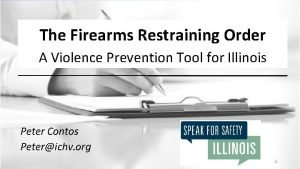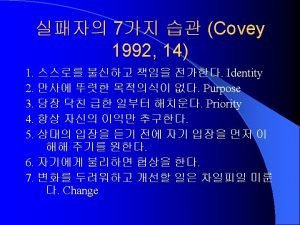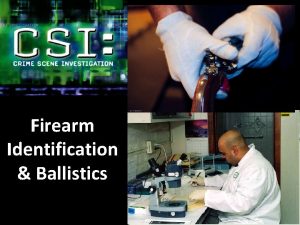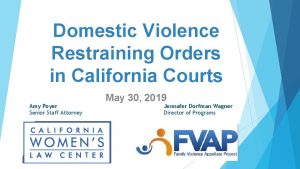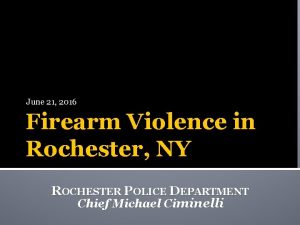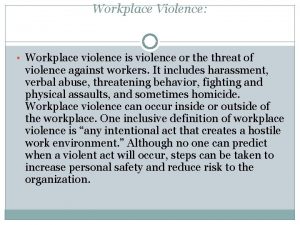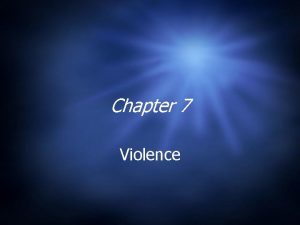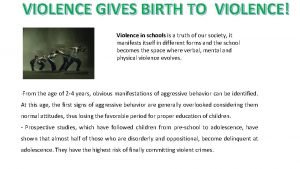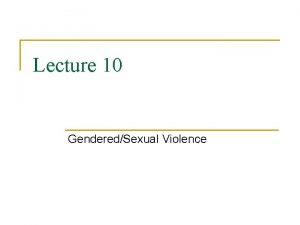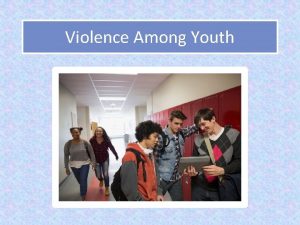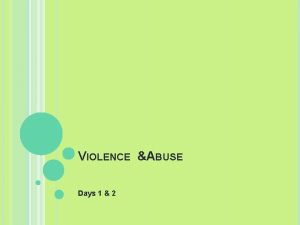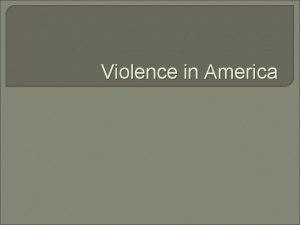The Firearm Restraining Order A Violence Prevention Tool



































- Slides: 35

The Firearm Restraining Order A Violence Prevention Tool for Illinois Presentation name* Your Name* Organization* Date* 1

Speaker Information Name Organization Position/Title Short bio (5 -7 sentences) INSERT SPEAKER HEADSHOT 2

What is a Firearm Restraining Order? The Firearm Restraining Order (FRO) allows family members, and law enforcement to work with courts to temporarily remove guns and prevent the purchase of new guns by individuals who pose a significant risk of harm to themselves or others. The FRO is a civil procedure, not a criminal one. The goal is to ensure safety of the individual and those around them. 3

How does a FRO help people in crisis stay safe? The FRO requires temporary removal of guns from the subject of the order and prohibits new purchases for the duration of the order. This creates safer circumstances for the individual to seek treatment, stabilize their behavior, or access resources to address the underlying causes of their dangerous behaviors. An Emergency FRO can last up to 14 days, while a Six-Month FRO can last up to six months (and can be renewed beyond that) after a court hearing is held. 4

History of the FRO in Illinois’ FRO law was established in response a series of deadly mass shootings and increased rates of suicide across the country. In the Summer of 2018, the bill was passed thanks to hard work from many stakeholders and legislators across Illinois, and became law on January 1 st of 2019. 5

Public Act 100 -0607 Firearm Restraining Orders Representative Kathleen Willis first introduced the FRO Bill on February 2 nd , 2018. After amendments and approval by IL House and Senate, the bill was presented to Governor Rauner June 28 th and signed July 16 th. The bill went into effect January 1 st of 2019. 6

Steps to Obtaining a FRO Request a petition from your local Superior Court or download one online. Complete and submit the petition to the Circuit Court in the county where the respondent (the person to be served with the FRO) lives. Note: Circuit Court Clerks are required to assist you with this process, free of charge. Check out How To File a FRO for more information. If the judge issues an FRO, local law enforcement will serve the order. In the case someone files directly for a Six-Month FRO, then the a notice for the hearing can be served by either local law enforcement or a special process server. Attend the hearing scheduled by the Court. A hearing will be scheduled within 14 of the issuance of an Emergency FRO or within 30 days of filing a petition for a Six-month FRO. 7

How Does a FRO get Approved? When attending a hearing to determine if a Six-Month FRO is necessary, Judges will make the decision whether or not to issue a FRO by considering several indicators of dangerousness: ● Recent threat or act of violence directed toward self or others ● Violation of a protective order currently in effect or unexpired ● Conviction for any crime that prohibits purchase and possession of firearms under Illinois law ● Unlawful and reckless use, display, or brandishing of a firearm In making FRO decisions, judges may also consider additional evidence of an increased risk for violence, including, but not limited to: ● Reckless firearm behaviors ● History of threatened, attempted, or actual physical force against another person ● Prior arrest for a felony offense ● History of violation of a protective order ● Records demonstrating abuse of alcohol or controlled substances. 8

What is the FRO law? Illinois Public Act 100 -0607 This law, passed in the Summer of 2018, allows for Illinoisans to use Firearm Restraining Orders to prevent violence in their home and community. It provides family members and law enforcement to be proactive in addressing their concerns, by providing them a civil measure to prevent a person who is exhibiting dangerous behavior from legally accessing firearms. For more information check out Illinois Public Act 100 -0607 9

What are the types of FROs available in Illinois? There are two types of FROs that may be issued: • Emergency Firearm Restraining Order (available to family members, roommates, and law enforcement) • Six-Month Firearm Restraining Order (available to family members, roommates and law enforcement) 10

Emergency FRO An emergency FRO is a type of order available to law enforcement and family members, and may be obtained with the oral approval of a judge on the same day it was filed. ● A hearing for an emergency order will be held on an “ex-parte” basis (without notice to the respondent) on the same day the order was filed. ● If a circuit or associate judge finds probable cause to believe that the respondent poses an immediate and present danger of causing personal injury to themselves or another person by having access to a firearm, the circuit or associate judge shall issue an emergency order. 11

Six-Month FRO When an Emergency FRO is issued, the court will schedule a hearing within 30 days to determine if a Six-Month FRO is necessary. In the case a petitioner applies directly for a Six-Month FRO, a hearing will be scheduled within 30 days. ● During the hearing the responding party has the opportunity to respond to the order, and the court will review the same type of evidence used when considering the emergency order. The court may also review testimony from the petitioner and any witnesses which they produce, including law enforcement officers. ● If the order is granted, it is issued for six months from the hearing date. ● A petitioner may petition for renewal of a Six-Month FRO up to three months before it expires. A FRO may not be renewed after it expires. 12

Firearm Removal Laws in Other States Since the Parkland Shooting February 15 th, 2018, 9 states have approved bills similar to Illinois’ Firearm Restraining Order law. Bringing the total number of states with Firearm Seizure laws to 14 and the District of Columbia. Many more states are also considering such laws. Source: State legislatures. Interactive: Daniel Nass. ; Graphic by the Trace 13

Academic Research on FROs 2017 Duke Study, Jeffrey W. Swanson et al. : ● Examined the results of Connecticut’s firearm seizure law which has been in effect since 1999. ● On average law enforcement removed 7 guns for each order. ● 1 in 3 subjects were given access to mental health care and drug/alcohol misuse counseling– often for the first time. ● For every 10 to 20 orders, at least one suicide was prevented. ● After the Virginia Tech shooting in 2007 the annual number of gun removals increased about fivefold—to about 100 cases per year. 14

Academic Research on FROs 2018 American Psychiatric Association Study ● Examined Indiana and Connecticut’s firearm seizure laws. ● Indiana’s firearm seizure law was associated with a 7. 5% reduction in firearm suicides in the ten years following its enactment. ● Enactment of Connecticut’s law was associated with a 1. 6% reduction in firearm suicides immediately after its passage and a 13. 7% reduction in firearm suicides in the post–Virginia Tech period, when enforcement of the law substantially increased. ● Risk-based firearm seizure laws were associated with reduced population-level firearm suicide rates. 15

We Believe the Current Number of FROs is Much Lower than the Potential As California has only issued around 200 orders since their version of the FRO (GVROs) law was enacted, we have not even begun to see the full potential for these orders to prevent gun violence. Only a handful of counties have accounted for the majority of the orders, with many of them being in urban areas like San Diego, not rural communities where rates of suicide are disproportionately high. In Connecticut, for every 10 to 20 firearm-removal orders issued at least one suicide was prevented, such an effect would save many lives in Illinois. Rates of suicide have risen steadily in the state since 1999, and rates of suicide among veterans continue to be staggeringly high. Almost 60% percent of Illinois veterans who died by suicide used a gun compared to the statewide rate of about 38% percent for the population in general 1. 16

We Believe the Current Number of FROs is Much Lower than the Potential (Con’t) FROs also have great potential to prevent premeditated shootings, and can proactively prevent harm when someone has threatened violence. In the case of California, 6 of San Diego’s 39+ Gun Violence Restraining Orders were against individuals who posed threats to students, teachers, or other school employees. While there is little data so far on the effects of firearm removals in California, the California Dept. of Justice Bureau of Firearms has prioritized firearm removals under GVROs, and sees them as a valuable tool for keeping law enforcement and communities safe. Law enforcement agencies in Santa Barbara have also used GVROs multiple times to disarm individuals whose gun use has been confrontational or dangerous before a situation gets out of hand. 17

Who Can Petition: Families/Households If you think there is a strong likelihood that a family member or roommate, or would harm themselves or others, petitioning for a FRO can be an important first step to reduce the risk of harm. If a loved one is experiencing an emotional crisis or is demonstrating signs of being dangerous such as suicidal thoughts, aggression, public threats of violence, or unsafe behavior with firearms, you can petition for a FRO. You may also contact your local sheriff or police department to inform them of an unsafe situation. An example of a scenario where a FRO could be appropriate: My son has been struggling at college and has alienated himself from his friends. Lately he has been posting violent content online and going to a shooting range. He owns a number of guns, and I am worried that he’s going through a crisis and needs help. 18

Who Can Petition: Law Enforcement If you think there is a strong likelihood that an individual would harm themselves or others, obtaining a FRO can be a proactive way to prevent violence and protect yourself and your fellow officers if a someone is demonstrating signs of being dangerous such as suicidal thoughts, aggression, public threats of violence, or other unsafe behavior with firearms. As a law enforcement officer you can obtain an emergency FRO, or a Six-Month FRO that can be renewed beyond six months. An example of a scenario where a FRO could be appropriate: A local man has threatened his neighbors with his guns, sometimes while he had been drinking. Although he has not yet harmed anyone, the situation has reached a boiling point, and we know from arrest records that he has been violent in the past. 19

Who Can Get Involved? (Attorneys) While only law enforcement and family members may petition for a FRO directly, as an attorney, you have an opportunity to advise or assist a client in obtaining a FRO, such as by helping them fill out the petition. Additionally talking to clients about safe gun ownership and storage is a potentially lifesaving action that can help keep them safe. If you are concerned that a client’s firearm usage may become violent or dangerous in the immediate future you may be able to go directly to law enforcement and they may obtain a FRO if they find it necessary to do so. An example of a scenario where a FRO could be appropriate: A client's family is concerned that their father, who has shown signs of depression and paranoia, may harm himself or their mother. There are lots of guns on the property, and they are almost never locked up. 20

Who Can Get Involved? (Eldercare) While only law enforcement and family members may petition for a FRO directly, as a caregiver, home visitor, or other elder care worker, you have an opportunity to advise a client or client’s family if a client’s usage has become unsafe. Including information about gun ownership and storage in the paperwork a client fills out can be helpful in keeping clients, and yourself, safe. An example of a scenario where a FRO could be appropriate: One of my clients is a 91 -year-old man showing signs of dementia. I serve as his companion most days and evening. I know that he keeps two loaded and unlocked guns in his home, and I am worried that he might hurt someone or himself. 21

Who Can Get Involved? (Faith Based) While only law enforcement and family members may petition for a FRO directly, as a member of a faith community, you may have an opportunity to connect with a fellow community member or congregation member if they are in crisis, or if someone in their family or household is in crisis or behaving violently. If someone’s gun use has become unsafe, a loved one may seek a FRO to allow that person to obtain the help that they need away from their firearms. The person then has the opportunity to return to responsible gun ownership once the order expires or is ended by a judge. An example of a scenario where a FRO could be appropriate: A church member has recently relapsed into alcoholism. His daughter who is also a church member is concerned that there are guns in the home that are unsecured but she is afraid to confront her dad about this in his current state. 22

Who Can Get Involved? (Fiduciaries) While only law enforcement and family members may petition for a FRO directly, as a fiduciary or conservator* you have an opportunity to inform a client’s family or law enforcement if a client’s gun usage has become unsafe. Doing so can help prevent gun violence, especially if you are concerned that a client may become violent or dangerous in the immediate future. Including information about gun ownership and storage in the paperwork a client fills out can also be helpful in keeping clients safe. An example of a scenario where a FRO could be appropriate: A client has become withdrawn and has shown signs of depression and paranoia. There are lots of guns on the property, and they are neither locked up nor properly secured. 23

Who Can Get Involved? (Health Care) While only law enforcement and family members may petition for a FRO directly, as a physician or health care provider you have an opportunity to talk to a patient, patient’s family, or law enforcement if a patient’s firearm usage has become unsafe. Doing so can help prevent gun violence or suicide, especially if you are concerned that a patient may become violent or dangerous in the immediate future. Talking to patients about safe gun ownership and storage is a potentially life-saving action that can help keep patients safe. An example of a scenario where a FRO could be appropriate: A patient has become withdrawn and has shown signs of depression and paranoia. There are lots of guns on his property, and they are neither locked up nor properly secured. 24

Who Can Get Involved? (Mental Health) While only law enforcement and family members may petition for a FRO directly, as a mental health professional you have an opportunity to talk to a patient, patient’s family, or law enforcement if a patient’s firearm usage has become unsafe. Illinois law allows for a psychotherapist to warn or advise family members or law enforcement of a patient’s dangerous intentions. Doing so can help prevent gun violence or suicide, especially if a patient may become violent in the immediate future. An example of a scenario where a FRO could be appropriate: A local man has threatened his wife and neighbor as he believes they are having an affair. While the family has been aware of the threats they have been afraid to go to the police. Recently the wife shared this information with a her psychotherapist, but they aren’t sure what they can do. 25

Who Can Get Involved? (Public Health) While only law enforcement and family members may petition for a FRO directly, as a public health professional you have an opportunity to help educate community members and families about the FRO and how it can reduce the potential for danger when someone’s gun ownership has become unsafe. Additionally, if you are concerned that a someone’s firearm usage may become violent or dangerous in the immediate future you may be able to go directly to law enforcement and they may obtain a FRO if they find it necessary to do so. An example of a scenario where a FRO could be appropriate: Workers with a local Alzheimer’s care center have experienced several firearm related incidents that could have been potentially dangerous. Some of their clients have dementia and keep unlocked guns at home. 26

Who Can Get Involved? (Veterans) While only law enforcement and family members may petition for a FRO directly, as a someone working with veterans you have an opportunity to help educate veterans and families about the life-saving potential of the FRO when someone’s gun ownership has become unsafe. Additionally, if you are concerned that a someone’s firearm usage may become violent or dangerous in the immediate future you may be able to go directly to law enforcement and they may obtain a FRO if necessary. An example of a scenario where a FRO could be appropriate: A veteran in our community recently threatened someone at a party with a firearm while drinking. His friends were able to talk him down but he refused to hand over is firearms. The police have been notified and they are petitioning for a GVRO so the man can seek help away from his guns. 27

What can you do to help? Here are some ways you or your organization can get involved: 1. Talk to your colleagues about the FRO, and share our handouts and other resources on how a FRO can be a proactive tool to prevent gun violence (all of which are available online). 2. Host a workshop or webinar featuring information on the FRO. 3. Include a reference to the FRO law and Speak. For. Safety. IL. org in your next newsletter, blog post, or other publication. 4. Invite a Speak for Safety representative to, or use our materials at an event or meeting you plan to host or attend. 5. Follow our Twitter account and “Like” Speak for Safety’s Facebook page to stay up-to-date on news and information on the FRO which you can share with your network. 6. Other opportunities/ideas? Please email: Peter@ICHV. org 28

Frequently Asked Questions Does someone need to be guilty of a crime to obtain a FRO? No. The FRO is a civil procedure, not a criminal one. The goal is to ensure safety and allow the subject of the FRO the opportunity to heal or stabilize. However, if the order is violated, the subject may be charged with a misdemeanor crime. Can the respondent of the petition contest a FRO? If the respondent of the petition disagrees with the order, they will have the opportunity to respond during the hearing contesting the order. If the order is issued, respondent’s are provided one opportunity during the duration of the order to file for termination of the order. This will require the scheduling of another hearing to determine if the respondent is a danger. 29

Frequently Asked Questions What's the difference between a FRO and a Domestic Violence Order of Protection? A FRO only prevents the subject of the order from possessing or obtaining firearms, it does not bar contact or require that the subject restrict themselves from being near the petitioner. For personal protection from a spouse, family member, or household member, one can proceed under the Illinois Domestic Violence Act for an Order of Protection. The process of obtaining a Order of Protection is similar to the FRO but there are different requirements and documentation needed to obtain an order. To learn more go to: http: //www. illinoisattorneygeneral. gov/women/idva. html 30

Questions? Visit Speakforsafety. IL. org or email Peter@ICHV. org Visit Speakfor. Safety. org or email speak 4 safety@gmail. com 31

Blank Slide for Additional Information Insert text. . . 32

Blank Slide for Additional Information Insert text. . . 33

Optional: Video with San Diego City Attorney Mara Elliott 34

Thank You! 35
 Primary prevention secondary prevention tertiary prevention
Primary prevention secondary prevention tertiary prevention Singeing in firearm injury
Singeing in firearm injury Characters of firearm injuries
Characters of firearm injuries Blowback phenomenon wound
Blowback phenomenon wound Sheep restraint
Sheep restraint Restraining forces of globalization
Restraining forces of globalization Restraining a goat
Restraining a goat Psychological restraint in animals
Psychological restraint in animals Importance of global marketing
Importance of global marketing Stamp workplace violence
Stamp workplace violence 1st order 2nd order 3rd order neurons
1st order 2nd order 3rd order neurons Questioning attitude human performance
Questioning attitude human performance Potter's tool is data cleaning tool
Potter's tool is data cleaning tool Hát kết hợp bộ gõ cơ thể
Hát kết hợp bộ gõ cơ thể Bổ thể
Bổ thể Tỉ lệ cơ thể trẻ em
Tỉ lệ cơ thể trẻ em Gấu đi như thế nào
Gấu đi như thế nào Tư thế worm breton
Tư thế worm breton Hát lên người ơi alleluia
Hát lên người ơi alleluia Môn thể thao bắt đầu bằng chữ f
Môn thể thao bắt đầu bằng chữ f Thế nào là hệ số cao nhất
Thế nào là hệ số cao nhất Các châu lục và đại dương trên thế giới
Các châu lục và đại dương trên thế giới Công thức tiính động năng
Công thức tiính động năng Trời xanh đây là của chúng ta thể thơ
Trời xanh đây là của chúng ta thể thơ Cách giải mật thư tọa độ
Cách giải mật thư tọa độ Phép trừ bù
Phép trừ bù độ dài liên kết
độ dài liên kết Các châu lục và đại dương trên thế giới
Các châu lục và đại dương trên thế giới Thơ thất ngôn tứ tuyệt đường luật
Thơ thất ngôn tứ tuyệt đường luật Quá trình desamine hóa có thể tạo ra
Quá trình desamine hóa có thể tạo ra Một số thể thơ truyền thống
Một số thể thơ truyền thống Cái miệng bé xinh thế chỉ nói điều hay thôi
Cái miệng bé xinh thế chỉ nói điều hay thôi Vẽ hình chiếu vuông góc của vật thể sau
Vẽ hình chiếu vuông góc của vật thể sau Nguyên nhân của sự mỏi cơ sinh 8
Nguyên nhân của sự mỏi cơ sinh 8 đặc điểm cơ thể của người tối cổ
đặc điểm cơ thể của người tối cổ

